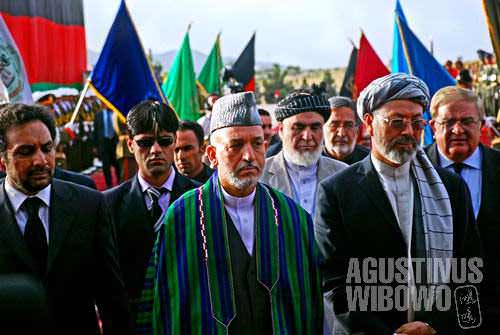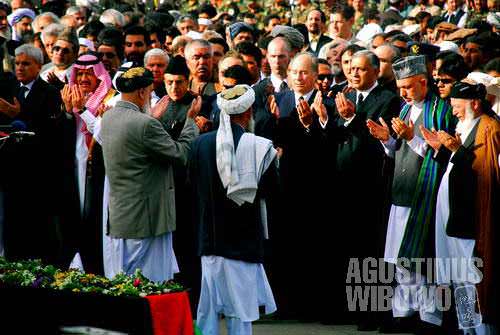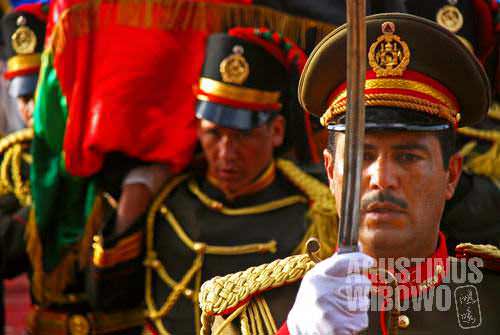Kabul – Funeral Ceremony of the ‘Father of Nation’

I have the rare opportunity to attend the state funeral ceremony of Muhammad Zahir Shah, the former and the last king of Afghanistan, who died at the age of 92. The king reigned from 1933 to 1973, before being overthrown by his own cousin Muhammad Daoud who started the history of Afghanistan as a republic.
The forty years of his monarchy leadership was always remembered as the peaceful era in Afghanistan history, which had been almost always carved by blood. His father, the king Nadir Shah, was assassinated by a student, which then brought the young Zahir, 19 years old at that time, to the throne. Assassinations and bloody coups are not new things in Afghanistan. Nadir came to power also due to a bloody civil war rouse by the controversial modernity programs promoted by the former king, Amanullah Khan. In 1929, there were three different kings sat on the throne consequently. People were sacrificed in struggle to power. It is blood which dominated history of Afghanistan.
During the reign of Zahir Shah, who saw the assassination of his father in front of his eyes, the country was relatively ‘quiet’. Young Zahir ascended to the throne, but in his first 20 years on throne, the young king reigned but did not rule. In later years, this last ruler of Pashtun dynasty in Afghanistan introduced advanced reforms, including modernization of the political structure and economic system of the country, introduction of a democratic legislature, education for women and other changes previously deemed taboo, like giving women the rights to vote and encouraging women to unveil. However, he was known to be Pashtun-ethnocentric (most of his government officials were Pasthun origin) and attempted to popularize Pashtu language over Persian. The modernization programs, especially those related to woman equality, challenged opposition from religious militants. The ethnocentric preference was another source of problems in the multiethnic country. The economy of the country was not especially prosperous as well, as the king did not have specific economic development programs. However, the long span of peace in turbulent Afghanistan was the most precious thing he could offer while others failed.

Afghan guards of honor with the casket of Zahir Shah
After Daoud’s coup, Zahir Shah was exiled in Europe. He was absent in Afghanistan when Russian troops invade Afghanistan; President Daoud was assassinated; Mujahiddin fighters fought against the Communist regime; the bloodshed poured in the civil war after the Soviet gave up Afghanistan; the Taliban gathered, conquered Kabul, slaughtered former Communist President Najibullah, and imposed strict Sharia and isolated the country from outside world. He experienced none of these. He was not among his people who suffered the turbulences, who had to crawl among ruins and smokes. He was not in Afghanistan when fighters put mines to kill the enemies and later generation has to be slaughtered and amputated due to the hidden landmines. He might hear the sorrow and cry of his people, but he could only able to watch from thousand miles of distance, from a residence villa north of Rome in Italy.

President Hamid Karzai and other Afghan senior officials
Three decades had passed, when Zahir Shah has the chance to return back to his homeland. Afghanistan – totally war-torn after Russian occupation, Communist regime, civil wars, and Taliban governance – had just saw American rockets bombarded Taliban bases and millions of Afghans were living on survival outside the country. The vigorous modernization programs started by his predecessor, Muhammad Daoud, was a slight hope for the country, but the Soviet invasion in 1979 ruined everything and brought era of lawlessness, turbulence, and civil war until Taliban regime with its extreme hard-line governance took control most of the country and brought the country back ‘quiet’. It was not too long afterwards when America started the invasion against Taliban ‘to bring justice to the people of Afghanistan’. The fundamentalist regime was toppled immediately. Afghanistan had just now started a new chapter on its history. A new ‘democratic’ government was set up. A new hope, built on rubbles and ruins, was sketched in his homeland, which he had been leaving for decades. It was in 2002, when the former king stepped on Afghanistan, which is now under American occupation.
About the former Taliban government, Zahir Shah avoided to speak out against the hard-line regime. In fact, the king-in-exile even sent Taliban a congratulation letter when the Pashtun fighters captured the northern city of Mazar-i-Sharif in 1998. He was well-known for his anti-Soviet and anti-Communist attitude, and during the Soviet occupation he was barred on returning home.
In 2002, upon his arrival, Afghanistan was on the crossroads. There were longing to return back to monarchy system, and there were calls for him to remain the king of Afghanistan. He refused the idea, and stated it clearly in front of Loya Jirga (the great council), which entitled him Baba-i-Millat (Father of Nation) instead of bestowing on him as a king. Zahir Shah stated, “I will accept the responsibility of head of state if that is what the loya jirga demands of me but I have no intention to restore the monarchy. I do not care about the title of king. The people call me Baba and I prefer this title.” (taken from here ). His ceremonial title was his role as Afghanistan symbol of national unity in the multiethnic, multi-faction country, despite of his past as an ethnocentric rule.

The president, among with some other honorary guests, pay respect to the deceased
Hamid Karzai then became the president of new Afghanistan, legitimated by world-watched democratic presidential election. The former monarch was respected nationwide as the symbol of unity, but held no more power than that. Zahir Shah’s health condition, along with his old age, was worsening. He was brought to foreign hospitals for femur break, intestinal problem, and nose bleeding. He was reported seriously ill by the beginning of this year, and not much of him heard by the publics.
His death on July 23, 2007 called Hamid Karzai to declare the country under three-day morning period. And today, July 24, a state funeral is to be held dedicated to the Father of Nation. The funeral is to be attended by the president himself, foreign dignitaries, state lawmakers, royal family members, and some other VIPs. The security in the capital was strained considerably.
The funeral starts in the Presidential Palace in Kabul. Entry to the palace is very restricted, and the security procedure in the fortified palace is very strict, resembled that of American embassy I wrote earlier in this blog note. The media allowed to cover the ceremony was registered a day before and quota of personnel from each media was also decided. Then upon entry, the media personnel have to follow security check procedure. All personal belongings have to be laid on the floor, body search is done by security guards, dogs check the belongings, then the security guards check whether the cameras are all cameras (not a bomb in disguise).
Then, after finishing the security check, media people are allowed to enter the ‘fort’. Not on foot but with supplied vehicle. The media people have a special place at the left side of the tribune. The cool palace ground was covered by cool shade of burgeoning pine trees. Chanting of prayers was played by the loud speakers. Flowing smooth. Bringing the atmosphere of condolence. Afghanistan flag in the palace ground was flown half-mast. The country is in mourning period.

Media personnel was requested to arrive at 1, but not until before 4 p.m. the coffin of the king, covered in Afghan tricolor flag (black, red, green), carried by the guards of honor to the garden. The atmosphere turned to be strained. Everybody stands up. Only photographers and cameramen crawl around to get the best angle, to capture the monumental moment of Afghan history: the final full stop of the monarchy pages.
The coffin is then placed on a table in the middle of the podium. Foreign dignitaries, local lawmakers, and family members attend the ceremony. The respected guests stand in queue, one by one makes a walk around the coffin, stands a while in front of it, offers prayers, and continue walking. A woman is hysterical and cries loud. But overall it was a fast ceremony, silent but deep.
Then it is the turn for the family members and the President to give the last honor to the former king. This scene is not to be seen by most people. Only people from few selected media are allowed to witness. I follow most of other media personnel to quit the arena to go to the Eidgah Mosque where the funeral prayer is to be hold.
The security is beefed up. The Palace security guards controlled every action of the media personnel, especially photographers – who often play naughtily to get the best angle. I was warned several time as I tried to crawl around to cover the ceremony in the Palace Ground by an officer, saying that if I keep moving like this he will throw me out. And now, the media personnel are lined in a queue, walking like a soldier march to the back gate of the palace, heading to the mosque by walking in line.

Ready for funeral
Eidgah mosque is the biggest mosque in Kabul with capacity of 2 million people. This is the place where the funeral prayer is to be offered. I see seas of Afghan men, but the strict security officers forbad all photographers and camera men to capture the scene. No, no photo, no film, no recording along the way. We have to wait until the group of president and foreign dignitaries (ambassadors, foreign ministry members, etc) and family members to finish their honor in the Presidential Palace about to arrive. Then we are placed at the gate of the mosque, face to face with President Hamid Karzai who prepares for the prayers at the middle of the front line. Next to him are the Ismaili leader Karim Aga Khan and the Pakistani Prime Minister, Shaukat Aziz. Indonesian ambassador is also seen offering the prayers among the VIP crowd. Helicopters are seen flying around the site, to secure this sensitive occasion.
Now time to run again. The coffin is to be buried on the top of Maranjan hill, in a mausoleum, at the same place as the tomb of Nadir Shah, father of Zahir Shah. There is a special bus for the press, who take all the personnel to the top of the mound. The Nadir Shah mausoleum is covered in tricolor textile, the Afghan national flag. A band of musicians, boy scouts, soldiers in various uniforms, and the gorgeous Afghan guards of honors are ready in their own positions: to conduct the extremely important state funeral and to secure the extremely sensitive occasion.

Mausoleum at Maranjan Hill
Media people are among those difficult to handle. There are more than 40 media personnel, from local and foreign media, to be controlled and prepared. The space given to the press is on the little stairs under the big mausoleum building, crowded. People shout each other, as everybody wants to get the best place to capture this rare moment in their media career. Photographers are among the most difficult to handle. When the cameramen have to put their big camera on tripod, then just stand tight, the photographers are known to keep moving right and left, forward and backward, to try the different angles for their photos. It is not uncommon that cameramen get angry when photographers come into the frame and block the camera. It is also strange that now even reporters without cameras try to sit in the best place as well, making less space available for the photographers. It is a mess among the media. But at the contrary, the overall ceremony is under a perfect order.
Another long wait before the group of the President and VIP guests arrive at this site. President Hamid Karzai – clad in a traditional blue-and-green Afghan robe – walks on the red carpet, next to Aga Khan – presumably the most important among the dignitaries, then followed by ambassadors from 36 embassies, ministers and legislators from some foreign countries, heads of UN and NGO missions, former president Rabbani, jihadi leaders (among which Abdul Rab Rasul Sayyaf, Sibghatullah Mujaddedi, and the Uzbek warlord Rashid Dostum), religious leaders, ministers and parliament members, and many other extremely respected guests. The coffin is brought by the guards of honor. The melancholy Afghan national anthem, along with 21-gun salute, makes the air filled by solemnity.

Rest in peace
6:10 p.m. The President and other Afghan VIPs followed the coffin to inside the mausoleum. This part of ceremony is closed to media’s eyes. Aga Khan and most other foreign dignitaries sit under the tent, waiting for the burial ceremony to finish. It’s only Muslim prayers chanting can be heard, to accompany the former king with the mourning of the nation.
The ceremony continues. Mr. Karzai receives condolence from the ambassadors and representatives of closely related countries. The ambassador of Indonesia, seen from my position which is quite far away, was only recognized from his black Malay cap.
Funeral finishes. Considering the current situation and conducted under extreme tight security, the safe funeral is a success itself. The history of Afghan monarchy has met its last page. A full stop can be given to the kingship history of Afghanistan, along with the last king who has just made an epilogue of his page. Father-of-nation, the symbol of unity of a country at crossroads, now has gone. Whether unity is taken away by the symbol bringer, or preserved in deep heart of the nation, is still to be answered. While the country still struggle with the worsening security situation along with kidnappings of foreigners by insurgence in different provinces, Baba-i-Millat is laid quietly to rest in a smooth, solemn state funeral.


Leave a comment